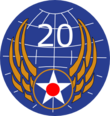John Wilson Carpenter III
John Wilson Carpenter III | |
|---|---|
John Wilson Carpenter III (August 11, 1916 – November 8, 1996) was a 1939 graduate of the
Education
Carpenter studied
Military career
Carpenter's first flying assignment was with the

Combat 1941-1942
When the Japanese attacked Clark Field on December 8, 1941, then-
Post-combat 1943-1944

After returning to the continental U.S., Carpenter served on tours of duty at Eglin Air Force Base, Florida; Headquarters Army Air Forces Bombardment Training Division, Washington, D.C.; and Headquarters Twentieth Air Force in Washington and the Mariana Islands.
B-29s
The new
Twentieth Air Force

The Twentieth Air Force was brought into existence on 4 April 1944 specifically to perform strategic bombardment missions against Japan. This was done at the insistence of

In addition Twentieth Air Force was chosen (secretly) to be the operational component of the Manhattan Project in 1944, and performed the atomic attacks on Japan in August 1945. In 1944, one of Carpenter's duties was to help oversee the personnel selected for the 509th Composite Group and to support the independence of this unit.[6]
Initially under the command of General
Operation Matterhorn
Operation Matterhorn was the name for the

By late 1944, it was becoming apparent that B-29 operations against Japan staged out of bases in China and India were far too expensive in men and materials and would have to be stopped. In December 1944, the Joint Chiefs of Staff made the decision that Operation Matterhorn would be phased out, and the 58th Bombardment Wing's B-29s would be moved to newly captured bases in the Marianas in the central Pacific. Carpenter moved there to help expedite the Twentieth Air Force mission and to help prepare for the movement of the 509th there.[5][6]
The
Post war
Later tours included
Retirement from active duty
Carpenter retired in the rank of
Military ranks
| O-1 | O-2 | O-3 | O-4 | O-5 | O-6 | O-7 | O-8 | O-9 | ||
|---|---|---|---|---|---|---|---|---|---|---|
| Insignia | 
|

|

|
|||||||
| Title | Second lieutenant
|
First lieutenant
|
Captain | Major | Lieutenant colonel | Colonel | Brigadier general | Major general | Lieutenant general | |
| Date of rank | 1939 | |||||||||
Decorations
Carpenter's military decorations include the
- Air Force Distinguished Service Medalwith one oak leaf cluster.
 Silver Star with two oak leaf clusters.
Silver Star with two oak leaf clusters. Legion of Merit with two oak leaf clusters.
Legion of Merit with two oak leaf clusters. Distinguished Flying Cross with two oak leaf clusters.
Distinguished Flying Cross with two oak leaf clusters. Air Medal with oak leaf cluster.
Air Medal with oak leaf cluster. American Defense Service Medal
American Defense Service Medal American Campaign Medal
American Campaign Medal- Asiatic-Pacific Campaign Medal
- World War II Victory Medal
See also
- West Point Memorial Page to Lt. Gen. John W. Carpenter III.
Notes
- ^ Air Force Library: Lt Gen John W. Carpenter, biography posted at URL http://airforce.dtic.mil/news/biographies/carpenter_jw.html[permanent dead link], 6 May 2000; http://www.af.mil/information/bios/bio.asp?bioID=4930 Archived 2013-03-31 at the Wayback Machine, updated 2010. NOTE: This reference is a public document, but has been quoted on the internet verbatim without reference to the original source, obscuring its primary source and implying it is copyrighted by the secondary source.
- ^ William H. Bartsch: December 8, 1941: MacArthur's Pearl Harbor, Texas A&M University Press, College Station, Tex., p. 331.
- ^ Gene Eric Salecker: Fortress Against the Sun: The B-17 Flying Fortress in the Pacific. Da Capo Press, Cambridge, Mass. and New York, 2001, p. 43.
- ^ Salecker, op. cit.
- ^ ISBN 0-283-98786-3.
- ^ ISBN 0-911852-85-9.
- ^ a b American Biographical Institute, op. cit.
- ^ Air Force Library, op. cit.
 This article incorporates public domain material from the Air Force Historical Research Agency
This article incorporates public domain material from the Air Force Historical Research Agency This article incorporates public domain material from 20th Air Force Website. United States Air Force.
This article incorporates public domain material from 20th Air Force Website. United States Air Force. This article incorporates public domain material from Biography on Lt. General John W. Carpenter III. United States Air Force.
This article incorporates public domain material from Biography on Lt. General John W. Carpenter III. United States Air Force.
References
- Marshall, Chester. Warbird History: B-29 Superfortress. Osceola, Wisconsin: Motorbooks International, 1993. ISBN 0-87938-785-8.
- Maurer, Maurer. Air Force Combat Units Of World War II. Maxwell Air Force Base, Alabama: Office of Air Force History, 1983. ISBN 0-89201-092-4.
- Rhodes, Richard. The Making of the Atomic Bomb. Simon and Schuster, 1986. ISBN 0-684-81378-5.
